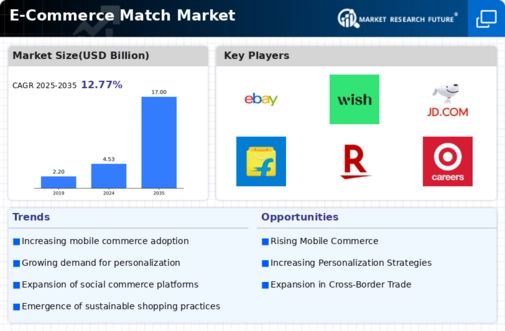Growth of Social Commerce
The E-Commerce Match Market is witnessing a significant rise in social commerce, where social media platforms serve as vital channels for product discovery and purchase. Recent data suggests that nearly 50 percent of consumers have made purchases directly through social media platforms. This trend is reshaping the landscape of e-commerce, as brands leverage social media to engage with consumers in more interactive and personalized ways. The E-Commerce Match Market is adapting by integrating shopping features into social media, allowing users to browse and buy products without leaving the platform. This shift not only enhances the shopping experience but also fosters community engagement, making social commerce a crucial driver for growth in the industry.
Increased Focus on Sustainability
The E-Commerce Match Market is increasingly aligning with consumer preferences for sustainability. Recent surveys indicate that approximately 70 percent of consumers are willing to pay more for products from environmentally responsible brands. This growing awareness is prompting e-commerce platforms to adopt sustainable practices, such as eco-friendly packaging and carbon-neutral shipping options. The E-Commerce Match Market is responding by highlighting sustainable products and practices, thereby attracting environmentally conscious consumers. This focus on sustainability not only enhances brand loyalty but also positions companies favorably in a competitive market. As sustainability becomes a core value for consumers, it is likely to drive innovation and reshape product offerings within the industry.
Advancements in Payment Technologies
The E-Commerce Match Market is significantly influenced by advancements in payment technologies, which are enhancing transaction security and convenience. The adoption of digital wallets and contactless payment methods has surged, with studies indicating that over 60 percent of consumers prefer these options for online transactions. This trend is prompting e-commerce platforms to integrate diverse payment solutions, thereby catering to varying consumer preferences. Additionally, the rise of cryptocurrencies as a payment option is beginning to gain traction, suggesting a potential shift in how transactions are conducted in the E-Commerce Match Market. As these technologies evolve, they are likely to play a pivotal role in shaping consumer trust and driving sales.
Emergence of Subscription-Based Models
The E-Commerce Match Market is experiencing a notable shift towards subscription-based models, which offer consumers convenience and value. This trend is evidenced by the increasing number of consumers opting for subscription services for various products, from groceries to fashion. Data suggests that subscription e-commerce has grown by over 20 percent in recent years, indicating a strong consumer preference for this model. The E-Commerce Match Market is adapting by providing tailored subscription options that cater to individual preferences, thereby enhancing customer retention. This model not only ensures a steady revenue stream for businesses but also fosters a sense of loyalty among consumers, making it a significant driver of growth in the industry.
Rising Consumer Demand for Convenience
The E-Commerce Match Market is experiencing a notable surge in consumer demand for convenience. As lifestyles become increasingly fast-paced, consumers are gravitating towards platforms that offer seamless shopping experiences. This trend is evidenced by the fact that approximately 70 percent of consumers prefer online shopping due to its convenience. The E-Commerce Match Market is adapting by enhancing user interfaces and streamlining checkout processes, thereby catering to this growing preference. Furthermore, the integration of features such as one-click purchasing and same-day delivery options is becoming commonplace, indicating a shift towards prioritizing consumer convenience. This driver not only reflects changing consumer behavior but also highlights the necessity for e-commerce platforms to innovate continuously in order to remain competitive.


















Leave a Comment